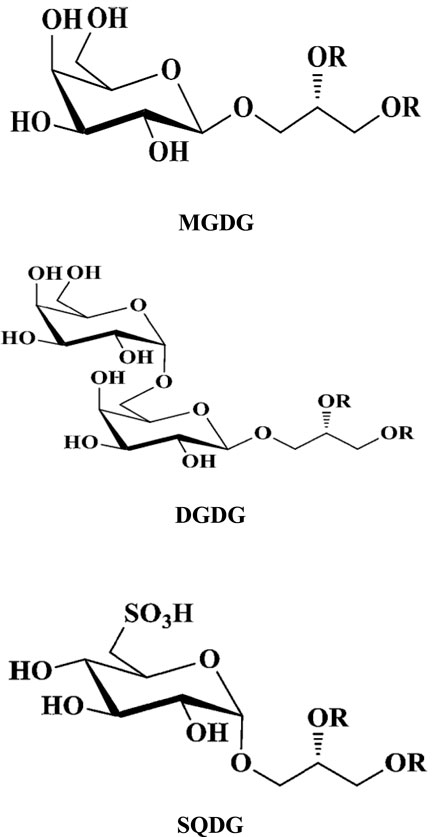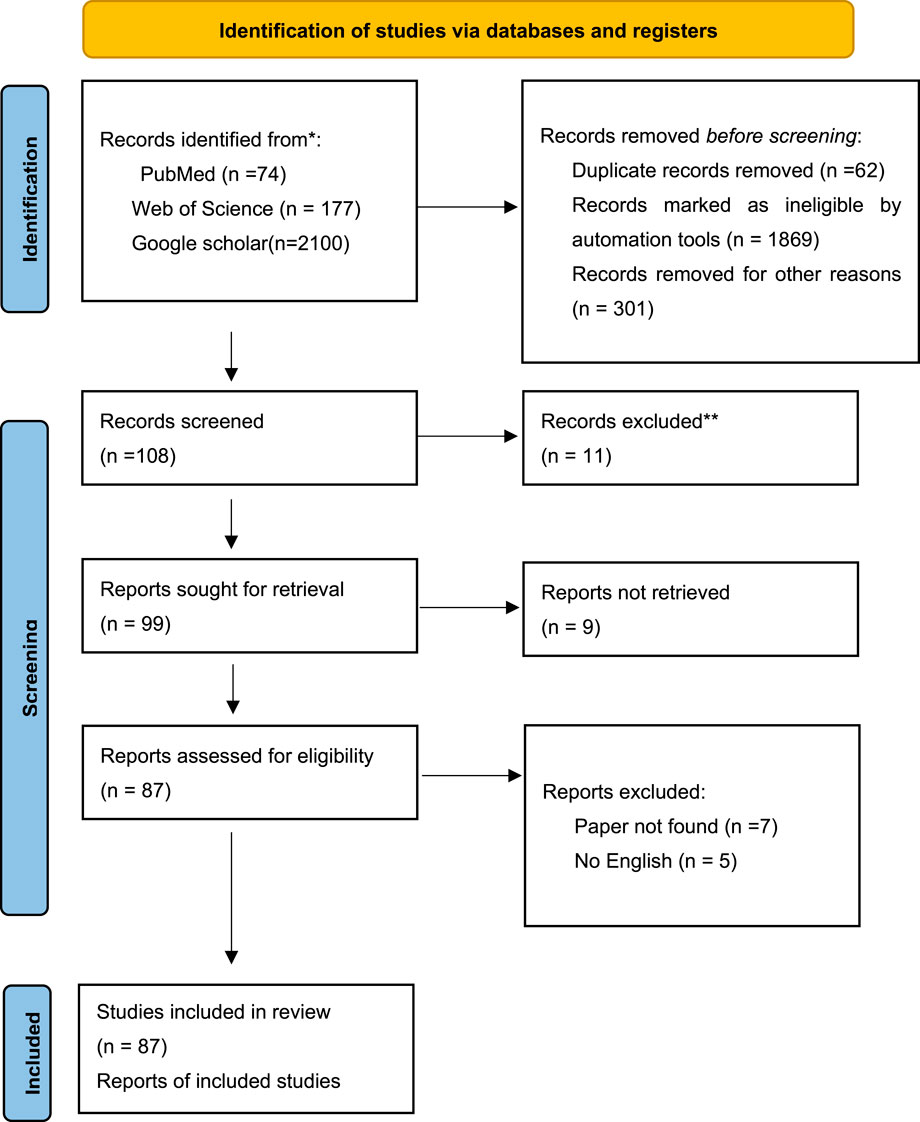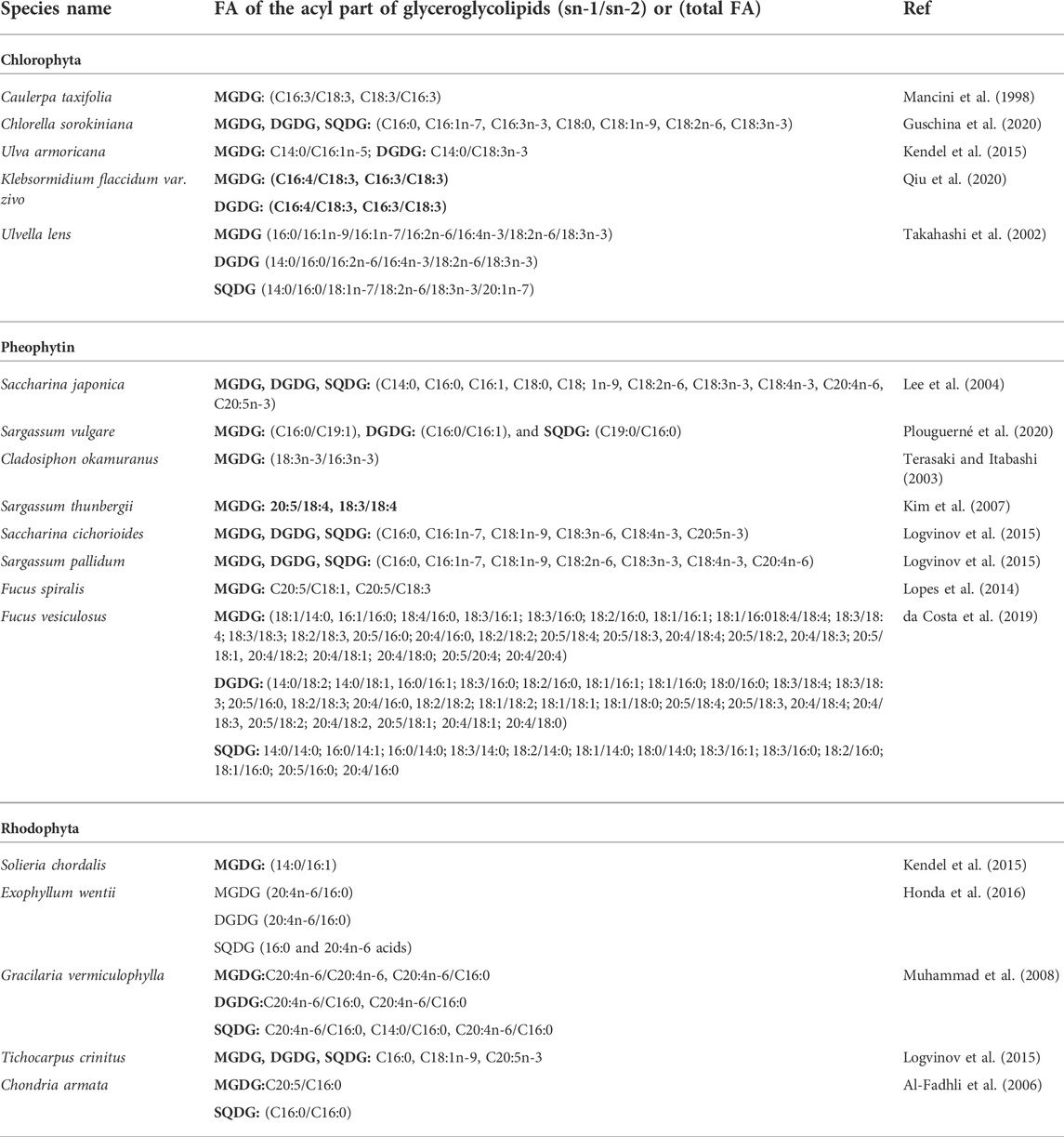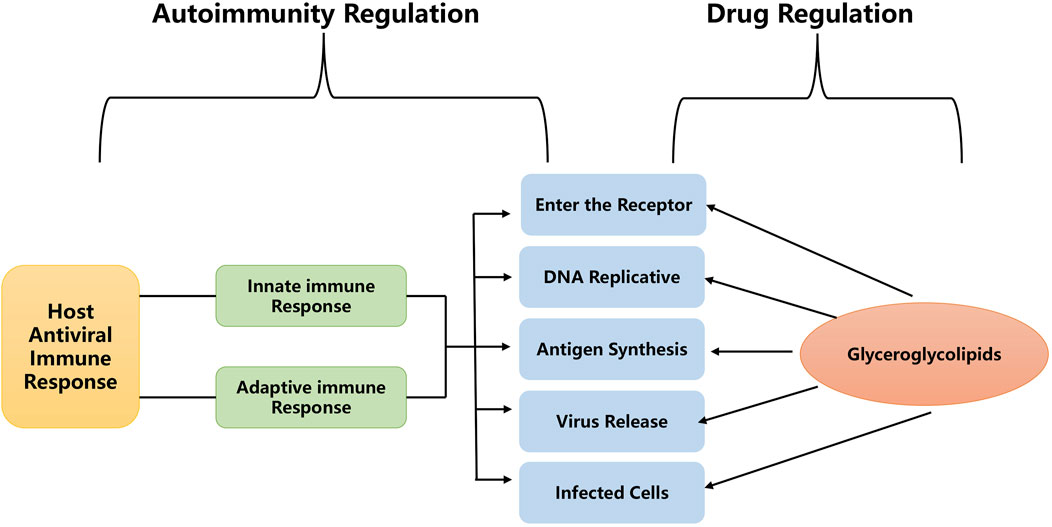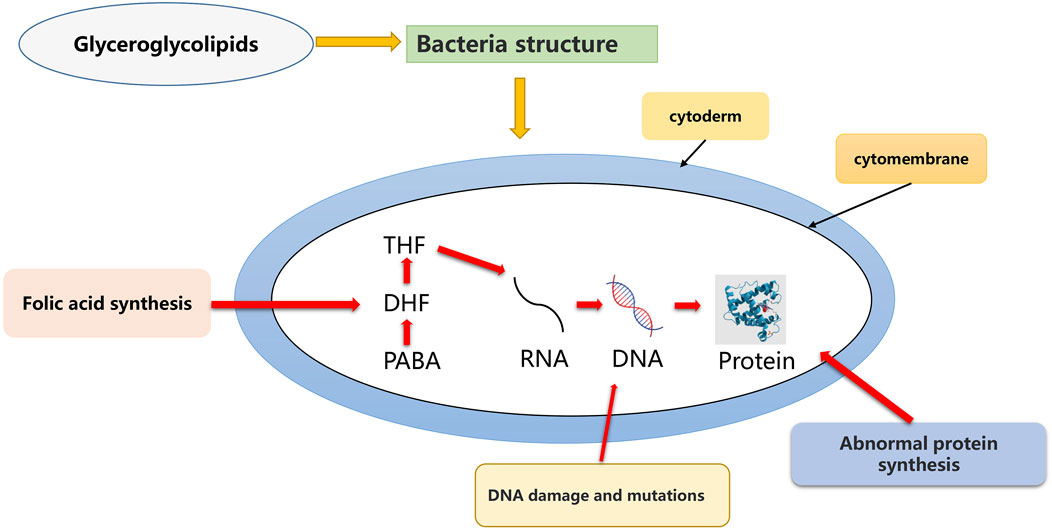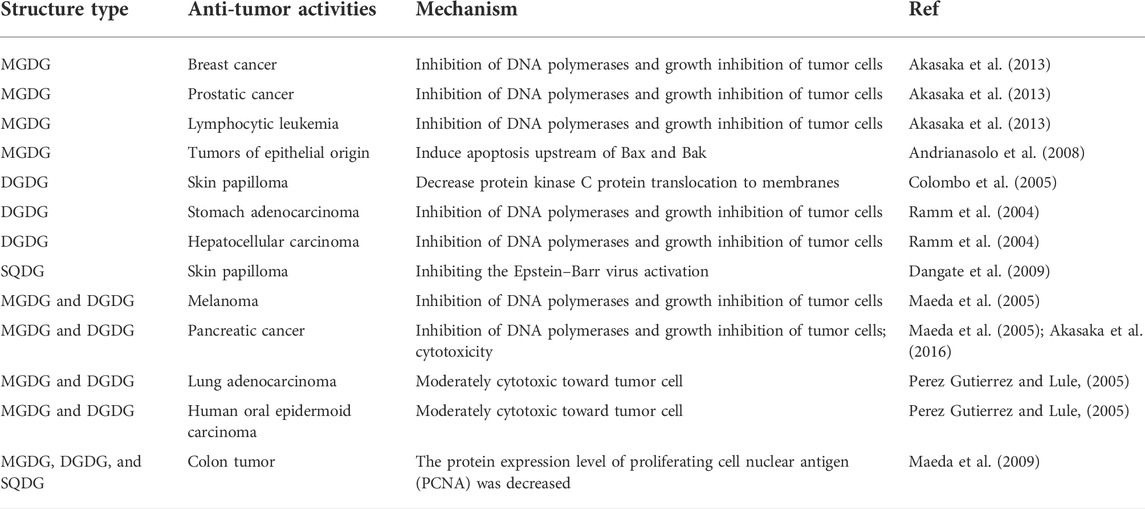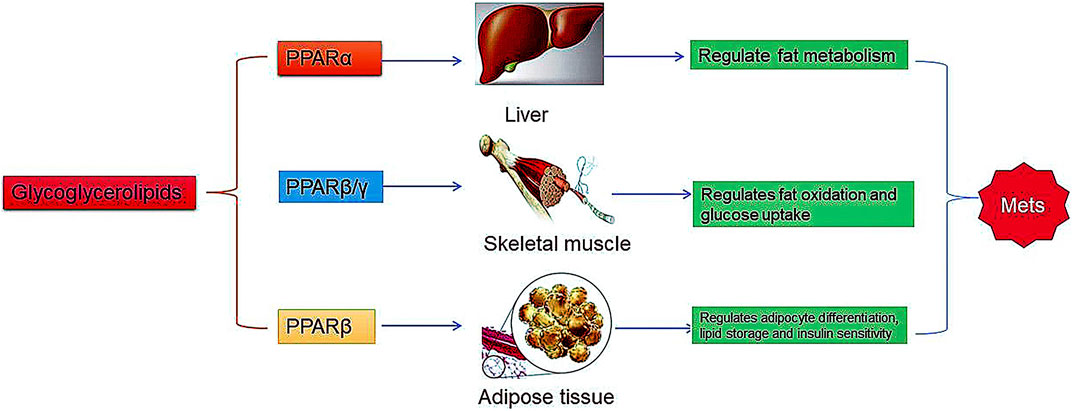- 1Key Laboratory of Theory of TCM, Ministry of Education of China, Shandong University of Traditional Chinese Medicine, Jinan, China
- 2Institute of Traditional Chinese Medicine Literature and Culture, Shandong University of Traditional Chinese Medicine, Jinan, China
Glyceroglycolipids are major metabolites of marine algae and have a wide range of applications in medicine, cosmetics, and chemistry research fields. They are located on the cell surface membranes. Together with glycoproteins and glycosaminoglycans, known as the glycocalyx, they play critical roles in multiple cellular functions and signal transduction and have several biological properties such as anti-oxidant and anti-inflammatory properties, anti-viral activity, and anti-tumor immunity. This article focused on the sources and pharmacological effects of glyceroglycolipids, which are naturally present in various marine algae, including planktonic algae and benthic algae, with the aim to highlight the promising potential of glyceroglycolipids in clinical treatment.
1 Introduction
Marine algae are photosynthetic plants with energy and nutritional value in the marine ecosystem. Although they are at the bottom of the food chain, they account for more than half of the biodiversity of the aquatic environment. In addition, marine algae represent a rich source of bioactive compounds and secondary metabolites (Saadaoui et al., 2020; Cepas et al., 2021). Based on differences in pigmentation, cell structure, reproductive method, and reproductive organ structure, there are about 27,000 species of marine algae and can be divided into planktonic algae, including Cyanobacteria, Chlamydomonas, Dinophyta, prochlorophytes, Euglena, xanthophyll, Cryptophyta, and diatoms, and benthic algae, including Chlorophyta, pheophytin, and Rhodophyta (Lordan et al., 2011; Guiry et al., 2021; Mandalka et al., 2022). Over the past decades, marine algae have been considered a major constituent for drug discovery. The massive diversification of marine algae in the marine ecosystem serves as a reservoir for a wide range of natural compounds (Agatonovic-Kustrin et al., 2018; Bharadwaj et al., 2022). Presently, marine algae are being researched as sources of food, medicine, cosmetics, fertilizer, fodder, and bioenergy (Zhang et al., 2022). However, the development and utilization of glyceroglycolipids in marine algae have been limited due to their low natural abundance.
Glyceroglycolipids have recently received increasing attention due to their anti-bacterial, anti-viral, anti-tumor, and anti-inflammatory activities (Hölzl and Dörmann, 2007; Michaud et al., 2017; Cepas et al., 2021). They are especially abundant in marine algae (Domingues and Calado, 2022) and can be divided into the following three main categories according to their chemical structures and types of glycosyl and acyl structures: monogalactosyl-diacylglycerols (MGDG), digalactosyl-diacylglycerol (DGDG), and sulfoquinovosyl-diacylglycerol (SQDG) (Marcolongo et al., 2006; Zhang et al., 2014) (Figure 1). Glyceroglycolipids constitute more than half of the total lipids (including fatty acids, glycerolipids, glycerophospholipids, sphingolipids, sterol lipids, saccharolipids, and polyketides). Glyceroglycolipids have several beneficial health effects, including their anti-tumor immunity, anti-oxidant and anti-inflammatory properties, and anti-viral activity (Morimoto et al., 1995; Loya et al., 1998). However, due to the low natural abundance of glyceroglycolipids in marine algae and the difficulty of separation, their development and utilization are subjected to certain restrictions.
In the past few years, there has been increasing interest in researching the benefits of natural pharmacological products in treating various diseases. This review provides a comprehensive overview of glyceroglycolipid libraries obtained from Web of Science, SciFinder, Medline, and other databases. To have an in-depth understanding of the glyceroglycolipids derived from marine algae and highlight their potential and prospects in biology, we summarized the literature on the source, structure, and pharmacology of glyceroglycolipids in marine organisms.
2 Methods and summary
2.1 Quality appraisal
The quality appraisal of articles was performed in phase three of the PRISMA flowchart (eligibility check) to ensure the quality of the included articles. Relevant information on the marine algae was obtained from scientific online databases such as Google Scholar, PubMed, and Web of Science. Additional information was derived from other literature sources (e.g., Chinese Pharmacopoeia 2020 edition, Chinese herbal classic books, PhD and MSc thesis, etc.). The search process was mainly based on keyword search, with the main keywords being marine algae, glyceroglycolipids, antitumor, antibacterial, and antiviral, etc., for which they were searched individually or in combination. The scope of the literature search was focused on literature reports between 2012 and 2022. Some of these studies were not reported in the last decade, and we extended the search to earlier literature.
The initial search resulted in 2,351 articles. Then, those identified as duplicate articles, editorials, letters, or basic science studies were excluded, and 99 full-text articles were identified. With detailed analysis, we excluded 12 full-text articles (5 non-English; 7 could not be found). A total of 87 full-text articles were found to be relevant for the systematic review (Figure 2).
2.2 Source and structure of glyceroglycolipids in marine algae
Glyceroglycolipids are especially abundant in marine algae and exhibit a glycerol backbone that anchors one or two acyl chains esterified at the sn-1 and sn-2 positions and a sugar group attached at the sn-3 position in a β-anomeric linkage (Demé et al., 2014; Hoyo et al., 2016). MGDG, DGDG, and SQDG are the most common glyceroglycolipids, which differ mainly in their fatty acid chain. The saturation and chain length of the fatty acid chains influence the biological activity of glyceroglycolipids. The former two glyceroglycolipids are neutral glycolipids, and the latter one is anionic sulfolipids (Alves et al., 2020; Chen and Wang, 2021). For the broad application of marine algae lipids, it is crucial to identify marine algae materials rich in glyceroglycolipids. Table 1 summarizes the form of fatty acids derived from glycerol in diverse marine algae sources, from which C16 and C18 can be seen as the main acyl fatty acid chains of glycerol glycolipids. According to some research, glycoglycerolipid biosynthesis mainly occurs via two routes: the prokaryotic pathway, which generates glyceroglycolipids with an sn-2 C16 acyl group, and the eukaryotic pathway, which generates glyceroglycolipids with an sn-2 C18 acyl group (Heinz and Roughan, 1983). Several studies have shown that glyceroglycolipids from marine algae have significant roles in connecting structural characteristics and pharmacological activities.
2.3 Pharmacological effects and mechanisms of glyceroglycolipids
Unlike polysaccharides and fatty acids in marine algae, the therapeutic benefits of glyceroglycolipids remain poorly understood in the current literature because of their limited natural abundance and absorption. Nevertheless, glyceroglycolipids can be digested and absorbed by the gastrointestinal tract (Bajwa and Sastry, 1974). Andersson et al. (1995) showed that pancreatic lipase-related proteins could hydrolyze galactosylglycerides into galactosylmonoglycerides (MGMGs) and diglycerides (DGMGs), then into galactosylglycerol (MGG) and diglycerides (DGG), and finally into galactosylglycerol and glycerol. Andersson et al. (1996) also reported that although the hydrolysis and cleavage of thioisorhamnosylglycerol- and galactosylglycerol-based skeleton structure might not occur in the colon, they could be further hydrolyzed into sugar and glycerin in the cecum, indicating that glyceroglycolipids are absorbed and transformed at different degrees in the intestine and that their biological activity could be determined by the absorption and transformation of their glycosyl structure and unsaturated fatty acid in vivo. Hence, this review investigates the pharmacology of different structural types of glyceroglycolipids in marine algae by mainly focusing on their anti-oxidant and anti-inflammatory properties, anti-viral activity, and anti-tumor immunity.
2.3 1 Anti-oxidant activities
Excessive oxygen free radicals have been associated with cardiovascular disease, aging, skin damage, and cancer (Block et al., 1983; Hassan and Abdel-Aziz, 2010). Cells and tissues have a complex anti-oxidant system to selectively scavenge excess free radicals and avoid damage to cellular structures. Therefore, supplementing exogenous anti-oxidants into diet and plant derivatives might have potential health benefits. In particular, although it is known that glycerolipids from marine algae have significant anti-oxidant activities, these roles have not been fully explored.
Genetic evidence suggests that membranes rich in polyunsaturated fatty acids (PUFAs) act as supramolecular anti-oxidants that capture reactive oxygen species, thereby limiting damage to proteins. This process generates lipid-fragmentation products, including malondialdehyde (MDA), an archetypal marker of PUFA oxidation. MGDG accelerates the rate at which MDA is metabolized (Schmid-Siegert et al., 2016). Another study showed that SQDG significantly inhibited LPS-induced NO production in RAW264.7 cells without affecting cell viability (Gao et al., 2014). Scavenging free radicals were shown to play important roles in human health, and marine algae-derived glyceroglycolipids were shown to possess significant anti-oxidant activities.
Overall, we found that the anti-oxidant mechanism of glyceroglycolipids could be explained by the fact that its unsaturated fatty acids play an important role in metabolites produced by lysis in the body, inhibiting the production of oxidizing substances such as NO in cells. As a result, the study of unsaturated fatty acid chains of glyceroglycolipids might become a hot topic in the future.
2.3.2 Anti-inflammatory activities
Glyceroglycolipids of natural origins have immunomodulatory properties (Cheng et al., 2016). Marine algae-derived glyceroglycolipids are immunosuppressive and can reduce inflammation by activating cells with immunosuppressive functions, such as regulatory T cells (Treg) (Mueller et al., 2010; Du et al., 2015). MGDG, DGDG, and SQDG have been found to exert anti-inflammatory effects by inducing superoxide anion production in leukocytes and chemotaxis of human peripheral neutrophils to inhibit croton oil-induced ear edema in mice (Bruno et al., 2005). In addition, MGDG and DGDG showed significant activity in lipopolysaccharide-stimulated human THP-1 macrophages to inhibit TNF-α production and activate anti-inflammatory mechanisms in the organism (De Los Reyes et al., 2016). Another study demonstrated that MGDG activated the cyclooxygenase-2 (COX-2) pathway and had anti-inflammatory activities on human articular cartilage (Ulivi et al., 2011). Furthermore, glyceroglycolipids of marine algae extracts were found to inhibit TNF-α-induced IL-8 production in the HT-29 cell line (Kiem et al., 2012). These studies suggest that glyceroglycolipids from marine algae might have anti-inflammatory effects.
Inflammatory mediators such as PGE2 and NO play key roles in every step of inflammation and have been implicated in the pathogenesis of various inflammatory diseases. Glycerol glycolipids were reported to inhibit LPS-induced protein and mRNA expression of iNOS and COX-2 in RAW264.7 macrophages and strongly inhibit NO and PGE2 production. At the same time, it also regulated the response of macrophages, as shown in Figure 3.
2.3.3 Anti-viral activities
Anti-viral chemotherapy is important in preventing and treating many important viral infections (De Clercq and Field, 2006; Plouguerné et al., 2013). However, the acceptance of anti-viral chemotherapy has been challenging mainly because clinicians were made to believe that viral inhibitors can have toxic effects on the host (Hayashi et al., 2019; Cénat et al., 2020; Sun et al., 2020). Currently, novel sources of anti-viral drugs are being actively researched. In the last few years, marine algae compounds have been examined for potential use in anti-viral drugs, of which glyceroglycolipids represent an emerging anti-viral secondary metabolite (Zhang X. et al., 2020). MGDG and DGDG are resistant to herpes simplex virus 2 (HSV-2) and can make the virus lose its ability to bind to cells and inhibit its replication in vivo (Hayashi et al., 2019; Wang et al., 2020). In addition, MGDG has anti-viral activity and can also combine with other substances to form immune complexes, which can stimulate the production of specific antibodies in vivo to inhibit influenza virus hemagglutinin (HA), thereby demonstrating its anti-viral effects (Nina et al., 2017). One study found that isolating SQDG from brown algae of Brazil also had inhibitory effects on herpes virus (HSV-1 and HSV-2) (Nina et al., 2017). In addition, a previous study reported that SQDG could inhibit HIV replication with the same effects as HIV reverse transcriptase through cell experiments (Gustafson et al., 1989). Ash et al. (2017) also studied the anti-viral activity of SQDG and found that the anti-viral mechanism of SQDG was mainly through the combination with DNA to induce apoptosis.
Based on the existing literature, we can conclude that there are three main anti-viral mechanisms of glycerol glycolipids: 1) preventing viral infection from entering the host cell by directly inhibiting the binding of the virus to the cell surface; 2) preventing the virus from exfoliating in the host cell by binding at the variable configuration site of the viral capsid; and 3) inhibiting the transcriptional replication process of the virus from the host cell by interfering with replication enzymes such as reverse transcriptase or preventing the formation of reverse transcriptase proteins of cellular messenger RNAs (Figure 4). Thus, marine algae glyceroglycolipids might be a primary candidate for the future anti-viral drug discovery work.
2.3.4 Anti-bacterial activities
Many highly effective antibiotics against bacteria and fungi are already in widespread use. However, due to the poor membrane permeability of many hydrophilic antibiotics, the choice of antimicrobial drugs for intracellular use is limited (Jiang et al., 2020). Recent studies have found glyceroglycolipids to have anti-bacterial activities. Dai et al. (2001) found that glycoglycerolipid could inactivate Bacillus. Plouguerné et al. (2014) reported that MGDG had strong anti-bacterial activity against Haemophilus influenzae, Legionella pneumophila, Propionibacterium acnes, Streptococcus pyogenes, Clostridium difficile, and Staphylococcus aureus. In addition, Parveez Ahamed et al. (2017) found that the acyl structure of glycerol glycolipid was related to its anti-bacterial activity. In addition, Furukawa et al. (2006) found that SQDG inhibited the proliferation of E. coli JM190 cells, while MGDG and DGDG did not show similar activities. These studies show the differences in the anti-bacterial activities of different structural types of glycoglycerolipids. However, there are few studies on the antimicrobial activity of glycolipids, of which most of the experiments have focused on their mechanism of action in vitro. Figure 5 summarizes the mechanism of action of various antimicrobial agents. Glyceroglycolipids were shown to disrupt mitochondrial functions in fungal cells in MTT assay (Lopes et al., 2013). Many dehydrogenases, such as lactate dehydrogenase and succinate, are involved in the mitochondrial respiratory chain. Glyceroglycolipids exert their anti-microbial effects by increasing the mitochondrial respiration rate and interaction with these enzymes, leading to higher ROS production.
2.3.5 Anti-tumor activities
Cancer is a major disease that reduces life expectancy. Currently, the main methods to treat tumors are surgery, radiotherapy, chemotherapy, and hormone therapy (Zhang W. et al., 2020). Although these methods can have certain therapeutic effects, in many cases, they also have serious adverse events (Rath et al., 2019; Yan et al., 2019). Therefore, research on more effective oncology drugs with lesser toxicity is of great significance and has become a research hotspot. Numerous studies have attempted to explain the strong anti-tumor activities of glyceroglycolipids. Shirahashi et al. (1993) reported that galactoglyceride significantly inhibited the growth of tumors. One study showed that DGDG had inhibitory effects on dermal papilloma in mice (Tokuda et al., 1996). Colombo et al. (2005) found that galactosylglycerides with more branched and unsaturated acyl chains had strong inhibitory effects on mouse skin tumors and proved that the acyl structure of glycerosylglycerides had a great influence on the activity of the glyceroglycolipids. In addition, they also found that the presence of aliphatic or aromatic rings in glycerol glycolipids had a negative effect on their anti-tumor activity (Colombo et al., 2006) and revealed that galactosylglycerides played a therapeutic role in cancer prevention and treatment by inhibiting the growth of tumor cells and blocking the expression of protein kinase C (Colombo et al., 2011). In addition, Akasaka et al. (2013) found that MGDG, a DNA polymerase inhibitor, can enhance the anti-proliferation effects of gemcitabine on human pancreatic cancer cells. However, Maeda et al. (2005) reported that glycerol glycolipid was not only an inhibitor of DNA polymerase but also a growth inhibitor of human gastric cancer cells, and its activity was stronger when it was hydrolyzed by lipase. Maeda et al. (2009) also reported that glycerol glycolipid had an inhibitory effect on the growth of transplanted tumor sarcoma and colon tumors in mice. Dangate et al. (2009) found that SQDG had anti-tumor effects and inhibited tumor promoters. Ogunsina et al. (2013) suggested that the glycosyl structure of glycerols was related to the activity of anti-tumor glycerides, and the anti-tumor activity of galactosyls was greatly lost when they were replaced. Andrianasolo et al. (2008) found that galactoglyceride induced apoptosis at micromolecular concentration and played an important role in the anti-tumor mechanism of glyceroglycolipids.
In summary, the three functions of glyceroglycolipids are crucial for tumor invasiveness and occur through different mechanisms at different sites (Table 2). Many studies have reported that glyceroglycolipids have unique advantages in immune regulation and anti-tumor activity. The anti-tumor effects of glyceroglycolipids are an active focus of research in pharmacology.
2.3.6 Treatment of metabolic diseases
Obesity and obesity-initiated metabolic syndrome are characterized by high levels of cholesterol and lipids in blood and intracellular fat accumulation in adipose tissues. Some researchers showed that glyceroglycolipids significantly reduced adipogenic PPAR-γ protein expression in differentiated 3T3-L1 cells (Chen et al., 2022; Prabhakar et al., 2022). Peroxisome proliferator-activated receptors (PPARs) are a family of ligand-regulated nuclear receptors that include PPAR-α, PPAR-β/δ, and PPAR-γ (Lee et al., 2022). These receptors play a significant role in the regulation of transcription, energy and lipid metabolism, and thermogenesis (Lee et al., 2020). One study identified a specific type of MGDG in which the acyl groups acted as a potent PPAR-γ (peroxisome proliferator-activated receptor γ) ligand (Figure 6) (Pinto et al., 2021). These studies suggest that algal-derived glycerolipids might be considered potential activation targets of the PPAR family, indicating the need for further in-depth analysis of marine algae and their natural products.
4 Conclusion
Glyceroglycolipids represent a broad class of biologically active natural products with a wide variety of molecular structures and biological functions, many of which are essential for life. They are naturally found in marine algae and appear to possess pharmacological activities such as anti-cancer, anti-bacterial, anti-viral, and anti-oxidant properties. There are various mechanisms underlying the activities of glyceroglycolipids, including the combination of cell signaling pathways at various stages of diseases.
In terms of anti-oxidants, the polyunsaturated fatty acids in glycerol glycolipids can reduce free peroxidation and rapidly scavenge malondialdehyde and are considered the main mechanisms of action. Meanwhile, glycerol glycolipids inhibited LPS-induced protein and mRNA expression of iNOS and COX-2 in RAW264.7 macrophages and strongly inhibited NO and PGE2 production. This mechanism indicates that glycerol glycolipids possess strong anti-inflammatory activities. In addition, glycerol glycolipids are also highly active against pathogenic microorganisms. Glyceroglycolipids prevent viral infection from entering the host cell by directly inhibiting the binding of the virus to the cell surface membrane. At the same time, polyunsaturated fatty acids bind to the variable conformation site of the viral shell and prevent viral shedding in host cells. Glycerolipids also exert anti-viral effects by interfering with replication enzymes (e.g., reverse transcriptase) or by preventing the formation of reverse transcriptase proteins of cellular messenger RNA, which inhibit the transcriptional replication process of viruses from host cells. In addition, the interaction of polyunsaturated fatty acids in glyceroglycolipids with various dehydrogenases increases the mitochondrial respiration rate, leading to higher ROS production, thus promoting anti-microbial effects. Glyceroglycolipids also have anti-cancer activities. Its main mechanisms of action include the inhibition of DNA polymerase and inhibition of tumor cell growth by inducing apoptosis upstream of Bax and Bak, reducing the transfer of protein kinase C protein to the membrane. The biological activity is closely related to the glycosyl and acyl chains of glyceroglycolipids. Consequently, it could be used in drugs for treating various diseases. However, due to the low natural abundance and difficult separation, research on the application of glycerolipids is limited. Meanwhile, the current research on glyceroglycolipids in marine algae remains under-investigated, urging the need for greater consideration due to their promising benefits.
Author contributions
S-SG conceived and designed the original manuscript and classified the pharmacological literature; and Z-GW proposed amendments and modified the manuscript. All authors contributed to the manuscript and approved the submitted version.
Funding
This study was funded by the National High Technology Research and Development Program of the Ministry of Science and Technology (863 Program), under No. 2013AA093001. Qi Huang Scholars Support Projecting.
Conflict of interest
The authors declare that the research was conducted in the absence of any commercial or financial relationships that could be construed as a potential conflict of interest.
Publisher’s note
All claims expressed in this article are solely those of the authors and do not necessarily represent those of their affiliated organizations, or those of the publisher, the editors, and the reviewers. Any product that may be evaluated in this article, or claim that may be made by its manufacturer, is not guaranteed or endorsed by the publisher.
References
Agatonovic-Kustrin, S., Kustrin, E., Angove, M. J., and Morton, D. W. (2018). A screening method for cardiovascular active compounds in marine algae. J. Chromatogr. A 1550, 57–62. doi:10.1016/j.chroma.2018.03.054
Akasaka, H., Mizushina, Y., Yoshida, K., Ejima, Y., Mukumoto, N., Wang, T., et al. (2016). MGDG extracted from spinach enhances the cytotoxicity of radiation in pancreatic cancer cells. Radiat. Oncol. 11 (1), 153. doi:10.1186/s13014-016-0729-0
Akasaka, H., Sasaki, R., Yoshida, K., Takayama, I., Yamaguchi, T., Yoshida, H., et al. (2013). Monogalactosyl diacylglycerol, a replicative DNA polymerase inhibitor, from spinach enhances the anti-cell proliferation effect of gemcitabine in human pancreatic cancer cells. Biochim. Biophys. Acta 1830 (3), 2517–2525. doi:10.1016/j.bbagen.2012.11.004
Al-Fadhli, A., Wahidulla, S., and Souza, L. (2006). Glycolipids from the red alga chondria armata (kutz.) okamura. Glycobiology 16 (10), 902–915. doi:10.1093/glycob/cwl018
Alves, E., Dias, M., Lopes, D., Almeida, A., Domingues, M., and Rey, F. (2020). Antimicrobial lipids from plants and marine organisms: An overview of the current state-of-the-art and future prospects. Antibiot. (Basel, Switz. 9 (8), 441. doi:10.3390/antibiotics9080441
Andersson, L., Bratt, C., Arnoldsson, K. C., Herslöf, B., Olsson, N. U., Sternby, B., et al. (1995). Hydrolysis of galactolipids by human pancreatic lipolytic enzymes and duodenal contents. J. Lipid Res. 36 (6), 1392–1400. doi:10.1016/S0022-2275(20)41146-0
Andersson, L., Carrière, F., Lowe, M. E., Nilsson, K., Verger, R., and Nilsson, A. (1996). Pancreatic lipase-related protein 2 but not classical pancreatic lipase hydrolyzes galactolipids. Biochim. Biophys. Acta 1302 (3), 236–240. doi:10.1016/0005-2760(96)00068-9
Andrianasolo, E. H., Haramaty, L., Vardi, A., White, E., Lutz, R., and Falkowski, P. (2008). Apoptosis-inducing galactolipids from a cultured marine diatom, Phaeodactylum tricornutum. J. Nat. Prod. 71 (7), 1197–1201. doi:10.1021/np800124k
Ash, A., Bharitkar, Y. P., Murmu, S., Hazra, A., Ravichandiran, V., Kar, P. K., et al. (2017). Ultrastructural changes in raillietina (Platyhelminthes: Cestoda), exposed to sulfonoquinovosyldiacylglyceride (SQDG), isolated from neem (Azadirachta indica). Nat. Prod. Res. 31 (20), 2445–2449. doi:10.1080/14786419.2017.1305383
Bajwa, S. S., and Sastry, P. S. (1974). Degradation of monogalactosyl diglyceride and digalactosyl diglyceride by sheep pancreatic enzymes. Biochem. J. 144 (2), 177–187. doi:10.1042/bj1440177
Bharadwaj, K. K., Ahmad, I., Pati, S., Ghosh, A., Sarkar, T., Rabha, B., et al. (2022). Potent bioactive compounds from seaweed waste to combat cancer through bioinformatics investigation. Front. Nutr. 9, 889276. doi:10.3389/fnut.2022.889276
Block, M. A., Dorne, A. J., Joyard, J., and Douce, R. (1983). Preparation and characterization of membrane fractions enriched in outer and inner envelope membranes from spinach chloroplasts. II. Biochemical characterization. J. Biol. Chem. 258 (21), 13281–13286. doi:10.1016/S0021-9258(17)44113-5
Bruno, A., Rossi, C., Marcolongo, G., Di Lena, A., Venzo, A., Berrie, C. P., et al. (2005). Selective in vivo anti-inflammatory action of the galactolipid monogalactosyldiacylglycerol. Eur. J. Pharmacol. 524 (1-3), 159–168. doi:10.1016/j.ejphar.2005.09.023
Cénat, J. M., Mukunzi, J. N., Noorishad, P. G., Rousseau, C., Derivois, D., and Bukaka, J. (2020). A systematic review of mental health programs among populations affected by the Ebola virus disease. J. Psychosom. Res. 131, 109966. doi:10.1016/j.jpsychores.2020.109966
Cepas, V., Gutiérrez-Del-Río, I., López, Y., Redondo-Blanco, S., Gabasa, Y., Iglesias, M. J., et al. (2021). Microalgae and cyanobacteria strains as producers of lipids with antibacterial and antibiofilm activity. Mar. Drugs 19 (12), 675. doi:10.3390/md19120675
Chen, B., Chen, H., Qu, H., Qiao, K., Xu, M., Wu, J., et al. (2022). Photoprotective effects of Sargassum thunbergii on ultraviolet B-induced mouse L929 fibroblasts and zebrafish. BMC Complement. Med. Ther. 22 (1), 144. doi:10.1186/s12906-022-03609-x
Chen, H., and Wang, Q. (2021). Regulatory mechanisms of lipid biosynthesis in microalgae. Biol. Rev. Camb. Philos. Soc. 96 (5), 2373–2391. doi:10.1111/brv.12759
Cheng, J. J., Chao, C. H., Chang, P. C., and Lu, M. K. (2016). Studies onanti-inflammatory activity of sulfated polysaccharides from cultivated fungi antrodia cinnamomea. Food Hydrocoll. 53, 37–45. doi:10.1016/j.foodhyd.2014.09.035
Colombo, D., Franchini, L., Toma, L., Ronchetti, F., Nakabe, N., Konoshima, T., et al. (2005). Anti-tumor-promoting activity of simple models of galactoglycerolipids with branched and unsaturated acyl chains. Eur. J. Med. Chem. 40 (1), 69–74. doi:10.1016/j.ejmech.2004.09.021
Colombo, D., Franchini, L., Toma, L., Ronchetti, F., Tanaka, R., Takayasu, J., et al. (2006). Cyclic and branched acyl chain galactoglycerolipids and their effect on anti-tumor-promoting activity. Eur. J. Med. Chem. 41 (12), 1456–1463. doi:10.1016/j.ejmech.2006.07.007
Colombo, D., Tringali, C., Franchini, L., Cirillo, F., and Venerando, B. (2011). Glycoglycerolipid analogues inhibit PKC translocation to the plasma membrane and downstream signaling pathways in PMA-treated fibroblasts and human glioblastoma cells, U87MG. Eur. J. Med. Chem. 46 (5), 1827–1834. doi:10.1016/j.ejmech.2011.02.043
da Costa, E., Domingues, P., Melo, T., Coelho, E., Pereira, R., Calado, R., et al. (2019). Lipidomic signatures reveal seasonal shifts on the relative abundance of high-valued lipids from the Brown algae fucus vesiculosus. Mar. Drugs 17 (6), 335. doi:10.3390/md17060335
Dai, J. Q., Zhu, Q. X., Zhao, C. Y., Yang, W., and Li, Y. (2001). Glyceroglycolipids from serratula strangulata. Phytochemistry 58 (8), 1305–1309. doi:10.1016/s0031-9422(01)00308-9
Dangate, M., Franchini, L., Ronchetti, F., Arai, T., Iida, A., Tokuda, H., et al. (2009). 2-O-beta-d-glucopyranosyl-sn-glycerol based analogues of sulfoquinovosyldiacylglycerols (SQDG) and their role in inhibiting Epstein-Barr virus early antigen activation. Bioorg. Med. Chem. 17 (16), 5968–5973. doi:10.1016/j.bmc.2009.06.064
De Clercq, E., and Field, H. J. (2006). Antiviral prodrugs the development of successful prodrug strategies for antiviral chemotherapy. Br. J. Pharmacol. 147 (1), 1–11. doi:10.1038/sj.bjp.0706446
de Los Reyes, C., Ortega, M. J., Rodríguez-Luna, A., Talero, E., Motilva, V., and Zubía, E. (2016). Molecular characterization and anti-inflammatory activity of galactosylglycerides and galactosylceramides from the microalga isochrysis galbana. J. Agric. Food Chem. 64 (46), 8783–8794. doi:10.1021/acs.jafc.6b03931
Demé, B., Cataye, C., Block, M. A., Maréchal, E., and Jouhet, J. (2014). Contribution of galactoglycerolipids to the 3-dimensional architecture of thylakoids. FASEB J. 28 (8), 3373–3383. doi:10.1096/fj.13-247395
Domingues, M. R., and Calado, R. (2022). Lipids of marine algae-biomolecules with high nutritional value and important bioactive properties. Biomolecules 12 (1), 134. doi:10.3390/biom12010134
Du, B., Lin, C., Bian, Z., and Xu, B. (2015). An insight into anti-inflammatory effects of fungal beta-glucans. Trends Food Sci. Technol. 41 (1), 49–59. doi:10.1016/j.tifs.2014.09.002
Furukawa, T., Nishida, M., Hada, T., Kuramochi, K., Sugawara, F., Kobayashi, S., et al. (2006). Inhibitory effect of sulfoquinovosyl diacylglycerol on prokaryotic DNA polymerase I activity and cell growth of Escherichia coli. J. Oleo Sci. 56 (1), 43–47. doi:10.5650/jos.56.43
Gao, Q. M., Yu, K., Xia, Y., Shine, M. B., Wang, C., Navarre, D. R., et al. (2014). Mono-and digalactosyldiacylglycerol lipids function nonredundantly to regulate systemic acquired resistance in plants. Cell Rep. 9 (5), 1681–1691. doi:10.1016/j.celrep.2014.10.069
Guiry, M. D., and Guiry, G. M.de maio de (2021). AlgaeBase. Galway: World-wide electronic publication, National University of Ireland.
Guschina, I. A., Hayes, A. J., and Ormerod, S. J. (2020). Polystyrene microplastics decrease accumulation of essential fatty acids in common freshwater algae. Environ. Pollut. 263, 114425. doi:10.1016/j.envpol.2020.114425
Gustafson, K. R., Cardellina, J. H., Fuller, R. W., Weislow, O. S., Kiser, R. F., Snader, K. M., et al. (1989). AIDS-antiviral sulfolipids from cyanobacteria (blue-green algae). J. Natl. Cancer Inst. 81 (16), 1254–1258. doi:10.1093/jnci/81.16.1254
Hassan, H. A., and Abdel-Aziz, A. F. (2010). Evaluation of free radical-scavenging and anti-oxidant properties of black berry against fluoride toxicity in rats. Food Chem. Toxicol. 48 (8-9), 1999–2004. doi:10.1016/j.fct.2010.05.018
Hayashi, K., Lee, J. B., Atsumi, K., Kanazashi, M., Shibayama, T., Okamoto, K., et al. (2019). In vitro and in vivo anti-herpes simplex virus activity of monogalactosyl diacylglyceride from coccomyxa sp. kj (ipod ferm bp-22254), a green microalga. PLoS ONE 14 (7), e0219305. doi:10.1371/journal.pone.0219305
Heinz, E., and Roughan, P. G. (1983). Similarities and differences in lipid metabolism of chloroplasts isolated from 18:3 and 16:3 plants. Plant Physiol. 72 (2), 273–279. doi:10.1104/pp.72.2.273
Hölzl, G., and Dörmann, P. (2007). Structure and function of glycoglycerolipids in plants and bacteria. Prog. Lipid Res. 46 (5), 225–243. doi:10.1016/j.plipres.2007.05.001
Honda, M., Ishimaru, T., and Itabashi, Y. (2016). Lipid classes, fatty acid composition, and glycerolipid molecular species of the red alga gracilaria vermiculophylla, a prostaglandin-producing seaweed. J. Oleo Sci. 65 (9), 723–732. doi:10.5650/jos.ess16026
Hoyo, J., Guaus, E., and Torrent-Burgués, J. (2016). Monogalactosyldiacylglycerol and digalactosyldiacylglycerol role, physical states, applications and biomimetic monolayer films. Eur. Phys. J. E Soft Matter 39 (3), 39. doi:10.1140/epje/i2016-16039-0
Jiang, Y., Han, M., Bo, Y., Feng, Y., Li, W., Wu, J. R., et al. (2020). "Metaphilic" cell-penetrating polypeptide-vancomycin conjugate efficiently eradicates intracellular bacteria via a dual mechanism. ACS Cent. Sci. 6 (12), 2267–2276. doi:10.1021/acscentsci.0c00893
Kendel, M., Wielgosz-Collin, G., Bertrand, S., Roussakis, C., Bourgougnon, N., and Bedoux, G. (2015). Lipid composition, fatty acids and sterols in the seaweeds ulva armoricana, and solieria chordalis from brittany (France): An analysis from nutritional, chemotaxonomic, and antiproliferative activity perspectives. Mar. Drugs 13 (9), 5606–5628. doi:10.3390/md13095606
Kiem, P. V., Minh, C. V., Nhiem, N. X., Cuong, N. X., Tai, B. H., Quang, T. H., et al. (2012). Inhibitory effect on TNF-α-induced IL-8 secretion in HT-29 cell line by glyceroglycolipids from the leaves of Ficus microcarpa. Arch. Pharm. Res. 35 (12), 2135–2142. doi:10.1007/s12272-012-1210-8
Kim, Y. H., Kim, E. H., Lee, C., Kim, M. H., and Rho, J. R. (2007). Two new monogalactosyl diacylglycerols from Brown alga Sargassum thunbergii. Lipids 42 (4), 395–399. doi:10.1007/s11745-007-3035-7
Lee, H. G., Jayawardena, T. U., Song, K. M., Choi, Y. S., Jeon, Y. J., and Kang, M. C. (2022). Dietary fucoidan from a Brown marine algae (Ecklonia cava) attenuates lipid accumulation in differentiated 3T3-L1 cells and alleviates high-fat diet-induced obesity in mice. Food Chem. Toxicol. 162, 112862. doi:10.1016/j.fct.2022.112862
Lee, H. G., Lu, Y. A., Li, X., Hyun, J. M., Kim, H. S., Lee, J. J., et al. (2020). Anti-obesity effects of grateloupia elliptica, a red seaweed, in mice with high-fat diet-induced obesity via suppression of adipogenic factors in white adipose tissue and increased thermogenic factors in Brown adipose tissue. Nutrients 12 (2), 308. doi:10.3390/nu12020308
Lee, I. A., Popov, A. M., Sanina, N. M., Kostetsky, E. Y., Shnyrov, V. L., Reunov, A. V., et al. (2004). Morphological and immunological characterization of immunostimulatory complexes based on glycoglycerolipids from laminaria japonica. Acta Biochim. Pol. 51 (1), 263–272. doi:10.18388/abp.2004_3619
Logvinov, S., Gerasimenko, N., Esipov, A., and Denisenko, V. A. (2015). Examination of the structures of several glycerolipids from marine macroalgae by NMR and GC-MS. J. Phycol. 51 (6), 1066–1074. doi:10.1111/jpy.12338
Lopes, G., Daletos, G., Proksch, P., Andrade, P. B., and Valentão, P. (2014). Anti-inflammatory potential of monogalactosyl diacylglycerols and a monoacylglycerol from the edible Brown seaweed Fucus spiralis Linnaeus. Mar. Drugs 12 (3), 1406–1418. doi:10.3390/md12031406
Lopes, G., Pinto, E., Andrade, P. B., and Valentao, P. (2013). Antifungal activity of phlorotannins against dermatophytes and yeasts: Approaches to the mechanism of action and influence on Candida albicans virulence factor. PLoS One 8 (8), e72203. doi:10.1371/journal.pone.0072203
Lordan, S., Ross, R. P., and Stanton, C. (2011). Marine bioactives as functional food ingredients: Potential to reduce the incidence of chronic diseases. Mar. Drugs 9 (6), 1056–1100. doi:10.3390/md9061056
Loya, S., Reshef, V., Mizrachi, E., Silberstein, C., Rachamim, Y., Carmeli, S., et al. (1998). The inhibition of the reverse transcriptase of HIV-1 by the natural sulfoglycolipids from cyanobacteria: Contribution of different moieties to their high potency. J. Nat. Prod. 61 (7), 891–895. doi:10.1021/np970585j
Maeda, N., Hada, T., Murakami-Nakai, C., Kuriyama, I., Ichikawa, H., Fukumori, Y., et al. (2005). Effects of DNA polymerase inhibitory and anti-tumor activities of lipase-hydrolyzed glycolipid fractions from spinach. J. Nutr. Biochem. 16 (2), 121–128. doi:10.1016/j.jnutbio.2004.08.005
Maeda, N., Kokai, Y., Ohtani, S., Hada, T., Yoshida, H., and Mizushina, Y. (2009). Inhibitory effects of preventive and curative orally administered spinach glycoglycerolipid fraction on the tumor growth of sarcoma and colon in mouse graft models. Food Chem. 112 (1), 205–210. doi:10.1016/j.foodchem.2008.05.059
Mancini, I., Guella, G., Defant, A., Candenas, M., Armesto, C., Depentori, D., et al. (1998). Polar metabolites of the tropical green SeaweedCaulerpa taxifolia Which Is Spreading in the mediterranean sea: Glycoglycerolipids and stable enols (α\=Keto esters). Helv. Chim. Acta 81 (9), 1681–1691. doi:10.1002/(sici)1522-2675(19980909)81:9<1681::aid-hlca1681>3.0.co;2-4
Mandalka, A., Cavalcanti, M., Harb, T. B., Toyota Fujii, M., Eisner, P., Schweiggert-, , et al. (2022). Nutritional composition of beach-cast marine algae from the Brazilian coast: Added value for algal biomass considered as waste. Foods (Basel, Switz. 11(9), 1201. doi:10.3390/foods11091201
Marcolongo, G., de Appolonia, F., Venzo, A., Berrie, C. P., Carofiglio, T., and Ceschi Berrini, C. (2006). Diacylglycerolipids isolated from a thermophile cyanobacterium from the Euganean hot springs. Nat. Prod. Res. 20 (8), 766–774. doi:10.1080/14786410500176393
Michaud, M., Prinz, W. A., and Jouhet, J. (2017). Glycerolipid synthesis and lipid trafficking in plant mitochondria. FEBS J. 284 (3), 376–390. doi:10.1111/febs.13812
Morimoto, T., Nagatsu, A., Murakami, N., Sakakibara, J., Tokuda, H., Nishino, H., et al. (1995). Anti-tumour-promoting glyceroglycolipids from the green alga, Chlorella vulgaris. Phytochemistry 40 (5), 1433–1437. doi:10.1016/0031-9422(95)00458-j
Mueller, M., Hobiger, S., and Jungbauer, A. (2010). Anti-inflammatory activity of extracts from fruits, herbs and spices. Food Chem. 122 (4), 987–996. doi:10.1016/j.foodchem.2010.03.041
Muhammad, I. I., Masaru, T., Ryo, N., Iijima, N., Hara, A., Fusetani, N., et al. (2008). Purification and characterization of glycerolipid acyl-hydrolase from the red alga gracilaria vermiculophylla. Fish. Sci. 74 (3), 670–676. doi:10.1111/j.1444-2906.2008.01573.x
Nina, S., Ludmila, D., Natalia, C., Eduard, K., and Valery, S. (2017). Modulation of immunogenicity and conformation of ha1 subunit of influenza a virus h1/n1 hemagglutinin in tubular immunostimulating complexes. Int. J. Mol. Sci. 18 (9), 1895. doi:10.3390/ijms18091895
Ogunsina, M., Pan, H., Samadder, P., Arthur, G., and Schweizer, F. (2013). Structure activity relationships of N-linked and diglycosylated glucosamine-based anti-tumor glycerolipids. Molecules 18 (12), 15288–15304. doi:10.3390/molecules181215288
Parveez Ahamed, A. A., Rasheed, M. U., Peer Muhamed Noorani, K., Reehana, N., Santhoshkumar, S., Mohamed Imran, Y. M., et al. (2017). In vitro anti-bacterial activity of MGDG-palmitoyl from Oscillatoria acuminata NTAPC05 against extended-spectrum β-lactamase producers. J. Antibiot. 70 (6), 754–762. doi:10.1038/ja.2017.40
Perez Gutierrez, R. M., and Lule, P. R. (2005). Cytotoxic constituents from Daphnia pulex. Pharm. Biol. 43 (4), 313–316. doi:10.1080/13880200590951702
Pinto, C., Ibáñez, M. R., Loyola, G., León, L., Salvatore, Y., González, C., et al. (2021). Characterization of an agarophyton chilense oleoresin containing PPARγ natural ligands with insulin-sensitizing effects in a C57Bl/6J mouse Model of diet-induced obesity and anti-oxidant activity in Caenorhabditis elegans. Nutrients 13 (6), 1828. doi:10.3390/nu13061828
Plouguerné, E., da Gama, B. A. P., Pereira, R. C., and Barreto-Bergter, E. (2014). Glycolipids from seaweeds and their potential biotechnological applications. Front. Cell. Infect. Microbiol. 4, 174. doi:10.3389/fcimb.2014.00174
Plouguerné, E., de Souza, L. M., Sassaki, G. L., Cavalcanti, J. F., Villela Romanos, M. T., da Gama, B. A., et al. (2013). Antiviral sulfoquinovosyldiacylglycerols (SQDGs) from the Brazilian Brown seaweed sargassum vulgare. Mar. Drugs 11 (11), 4628–4640. doi:10.3390/md11114628
Plouguerné, E., De Souza, L. M., Sassaki, G. L., Hellio, C., Trepos, R., Da Gama, B. A., et al. (2020). Acidification in the U.S. Southeast: Causes, potential consequences and the role of the southeast ocean and coastal acidification network. Front. Mar. Sci. 7, 1–548. doi:10.3389/fmars.2020.00548
Prabhakar, L., Dicky John, D. G., Singh, S. R., and Murali, A. (2022). Computational analysis of marine algal compounds for obesity management against pancreatic lipase. J. Biomol. Struct. Dyn. 1, 1–10. doi:10.1080/07391102.2022.2074139
Qiu, S., Khan, S. I., Wang, M., Zhao, J., Ren, S., Khan, I. A., et al. (2020). Chemometrics-assisted identification of anti-inflammatory compounds from the green alga Klebsormidium flaccidum var. Molecules 25 (5), 1048. doi:10.3390/molecules25051048
Ramm, W., Schatton, W., Wagner-Döbler, I., Wray, V., Nimtz, M., Tokuda, H., et al. (2004). Diglucosyl-glycerolipids from the marine sponge-associated Bacillus pumilus strain AAS3: Their production, enzymatic modification and properties. Appl. Microbiol. Biotechnol. 64 (4), 497–504. doi:10.1007/s00253-003-1471-8
Rath, P. D., Chen, D. Y., Gu, J., Lee, V., Al Ani, N. A., Shirazy, K., et al. (2019). Anti-tumor necrosis factor biosimilars and intended copies in rheumatology: Perspective from the Asia Pacific region. Int. J. Rheum. Dis. 22 (1), 9–24. doi:10.1111/1756-185X.13371
Saadaoui, I., Rasheed, R., Abdulrahman, N., Bounnit, T., Cherif, M., Jabri, H. A., et al. (2020). Algae-derived bioactive compounds with anti-lung cancer potential. Mar. Drugs 18 (4), E197. doi:10.3390/md18040197
Schmid-Siegert, E., Stepushenko, O., Glauser, G., and Farmer, E. E. (2016). Membranes as structural anti-oxidants: Recycling of malondialdehyde to its source in oxidation-sensitive chloroplast fatty acids. J. Biol. Chem. 291 (25), 13005–13013. doi:10.1074/jbc.M116.729921
Shirahashi, H., Murakami, N., Watanabe, M., Nagatsu, A., Sakakibara, J., Tokuda, H., et al. (1993). Isolation and identification of anti-tumor-promoting principles from the fresh-water cyanobacterium Phormidium tenue. Chem. Pharm. Bull. 41 (9), 1664–1666. doi:10.1248/cpb.41.1664
Sun, Z., Thilakavathy, K., Kumar, S. S., He, G., and Liu, S. V. (2020). Potential factors influencing repeated SARS outbreaks in China. Int. J. Environ. Res. Public Health 17 (5), 1633. doi:10.3390/ijerph17051633
Takahashi, Y., Itoh, K., Ishii, M., Suzuki, M., and Itabashi, Y. (2002). Induction of larval settlement and metamorphosis of the sea urchin strongylocentrotus intermedius by glycoglycerolipids from the green alga ulvella lens. Mar. Biol. 140 (4), 763–771. doi:10.1007/s00227-001-0749-6
Terasaki, M., and Itabashi, Y. (2003). Glycerolipid acyl hydrolase activity in the Brown alga Cladosiphon okamuranus TOKIDA. Biosci. Biotechnol. Biochem. 67 (9), 1986–1989. doi:10.1271/bbb.67.1986
Tokuda, H., Nishino, H., Shirahashi, H., Murakami, N., Nagatsu, A., and Sakakibara, J. (1996). Inhibition of 12-O-tetradecanoylphorbol-13-acetate promoted mouse skin papilloma by digalactosyl diacylglycerols from the fresh water cyanobacterium Phormidium tenue. Cancer Lett. 104 (1), 91–95. doi:10.1016/0304-3835(96)04237-1
Ulivi, V., Lenti, M., Gentili, C., Marcolongo, G., Cancedda, R., and Descalzi Cancedda, F. (2011). Anti-inflammatory activity of monogalactosyldiacylglycerol in human articular cartilage in vitro: Activation of an anti-inflammatory cyclooxygenase-2 (cox-2) pathway. Arthritis Res. Ther. 13 (3), R92. doi:10.1186/ar3367
Wang, F., Ding, D., Li, J., He, L., Xu, X., Zhao, Y., et al. (2020). Characterisation of genes involved in galactolipids and sulfolipids metabolism in maize and arabidopsis and their differential responses to phosphate deficiency. Funct. Plant Biol. 47, 279–292. doi:10.1071/FP19082
Yan, H., Xue, Z., Xie, J., Dong, Y., Ma, Z., Sun, X., et al. (2019). Toxicity of carbon nanotubes as anti-tumor drug carriers. Int. J. Nanomedicine 14, 10179–10194. doi:10.2147/IJN.S220087
Zhang, H., Jiang, F., Zhang, J., Wang, W., Li, L., and Yan, J. (2022). Modulatory effects of polysaccharides from plants, marine algae and edible mushrooms on gut microbiota and related health benefits: A review. Int. J. Biol. Macromol. 204, 169–192. doi:10.1016/j.ijbiomac.2022.01.166
Zhang, J., Li, C., Yu, G., and Guan, H. (2014). Total synthesis and structure-activity relationship of glycoglycerolipids from marine organisms. Mar. Drugs 12 (6), 3634–3659. doi:10.3390/md12063634
Zhang, W., Huang, Q., Xiao, W., Zhao, Y., Pi, J., Xu, H., et al. (2020). Advances in anti-tumor treatments targeting the CD47/SIRPα Axis. Front. Immunol. 11, 18. doi:10.3389/fimmu.2020.00018
Keywords: glyceroglycolipids, source, structure, pharmacological, marine algae
Citation: Guo S-s and Wang Z-g (2022) Glyceroglycolipids in marine algae: A review of their pharmacological activity. Front. Pharmacol. 13:1008797. doi: 10.3389/fphar.2022.1008797
Received: 01 August 2022; Accepted: 10 October 2022;
Published: 21 October 2022.
Edited by:
Hidayat Hussain, Leibniz Institute of Plant Biochemistry, GermanyReviewed by:
Bingmei M. Fu, City College of New York (CUNY), United StatesDeny Susanti, International Islamic University Malaysia, Malaysia
Copyright © 2022 Guo and Wang. This is an open-access article distributed under the terms of the Creative Commons Attribution License (CC BY). The use, distribution or reproduction in other forums is permitted, provided the original author(s) and the copyright owner(s) are credited and that the original publication in this journal is cited, in accordance with accepted academic practice. No use, distribution or reproduction is permitted which does not comply with these terms.
*Correspondence: Zhen-guo Wang, emhlbmd1b3dAMTI2LmNvbQ==
 Sha-sha Guo
Sha-sha Guo Zhen-guo Wang
Zhen-guo Wang